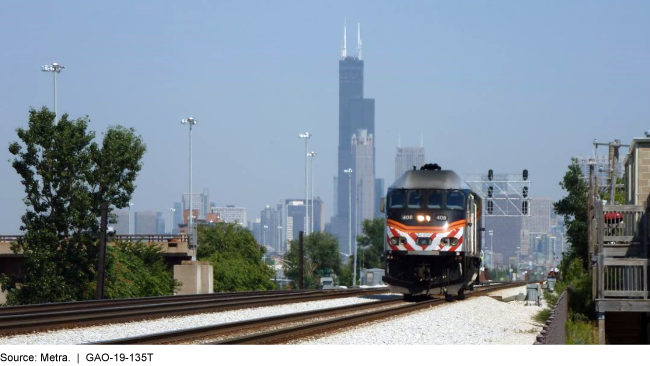Positive Train Control: Most Passenger Railroads Expect to Request an Extension and Substantial Work Remains Beyond 2018
Fast Facts
Forty railroads, including Amtrak, commuter, and freight railroads, are required to implement positive train control (PTC)—a communications-based system designed to slow or stop a train that is not being operated safely. Although the deadline for PTC implementation is December 31, 2018, railroads that meet certain criteria may receive a maximum 2-year extension.
We testified that, as of June 30, 2018, many passenger railroads remain in the early stages of PTC implementation, such as equipment installation and early testing. Most passenger railroads anticipate needing an extension.

Photograph of passenger rail locomotive
Highlights
What GAO Found
As of June 30, 2018, passenger railroads (28 commuter railroads and Amtrak) generally remained in the early stages of positive train control (PTC) implementation—including equipment installation and early field testing. However, many passenger railroads are nearing completion of the equipment installation stage. For example, two-thirds of passenger railroads reported being more than 90 percent complete with equipment installation. With regard to testing, Amtrak has reported that it has initiated both field testing and revenue service demonstration (RSD), an advanced form of field testing that is required to fully implement PTC. However, most commuter railroads reported slower progress with testing. Of the 28 commuter railroads required to implement PTC, 19 reported initiating field testing, but only eight reported initiating RSD. The Federal Railroad Administration (FRA) recently clarified the criteria railroads must meet to qualify for a 2-year extension past the December 31, 2018, PTC implementation deadline. To receive an extension, railroads must meet six statutory criteria. For the sixth criterion, commuter railroads are authorized to either initiate RSD on at least one track segment or use FRA-approved substitute criteria. FRA clarified these and other requirements at three PTC symposiums hosted for railroads in summer 2018. For example, FRA officials said that initiating field testing instead of RSD was one approach that commuter railroads could potentially take to receive FRA's approval of substitute criteria. FRA's actions are consistent with GAO's March 2018 recommendation that the agency communicate to railroads the requirements and process for an extension.
Challenges related to PTC implementation and FRA's resources raise questions as to the extent FRA and the passenger railroad industry are poised for full PTC implementation by December 31, 2020. Most passenger railroads anticipate needing an extension, leaving substantial work for both railroads and FRA to complete before the end of 2020. Almost three-quarters of passenger railroads (21 of 29) reported that they, or the railroad which owns the track on which they operate, will apply for an extension. More than half of these railroads reported planning to apply for an extension using substitute criteria, and of these, eight intend to apply for substitute criteria based on field testing. Though use of substitute criteria is authorized in law, this approach defers time-intensive RSD testing into 2019 and beyond. In addition, passenger railroads reported that they continue to face many of the same challenges GAO previously identified, such as software defects and limited industry-wide availability of vendors. Further, passenger railroads expressed concern that FRA's workload will markedly increase as railroads submit requests for extension approvals. FRA has acknowledged concerns about the pending surge of submissions and agency officials said they have taken recent steps to help manage the forthcoming influx of documentation, such as reallocating resources. However, as of September 21, 2018, only one passenger railroad had applied for an extension. It remains unclear how many extension requests FRA will receive or what FRA's enforcement strategy will be for noncompliance with the statute, such as for railroads that fail to apply for an extension by the deadline.
Why GAO Did This Study
Forty railroads are currently required by statute to implement PTC, a communications-based system designed to slow or stop a train that is not being operated safely. Of these, 29 passenger railroads collectively provide over 500 million passenger trips annually. Although the deadline for PTC implementation is December 31, 2018, railroads may receive a maximum 2-year extension to December 31, 2020, if they meet certain statutory criteria.
GAO was asked to review passenger railroads' progress toward PTC implementation. This statement discusses (1) passenger railroads' PTC progress and FRA's steps to assist them, and (2) how passenger railroads and FRA plan to approach the 2018 and 2020 deadlines. GAO analyzed railroads' most recent quarterly reports covering activities through June 30, 2018; sent a brief questionnaire to all 40 railroads; and interviewed officials from FRA and 16 railroads, selected in part based on those identified as at-risk by FRA.
Recommendations
In March 2018, GAO recommended FRA take steps to systematically communicate extension information to railroads and to use a risk-based approach to prioritize agency resources and workload. FRA has taken some steps to address these recommendations, such as recently communicating and clarifying extension requirements to all railroads during three symposiums. GAO will continue to monitor FRA's progress.
